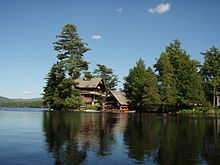Sagamore Camp
Sagamore Camp, or Sagamore Lodge , was formerly the luxurious, rural residence of the millionaire heir and businessman Alfred Gwynne Vanderbilt . The camp is located on a peninsula of the small Raquette Lake in the Adirondack Mountains , in the north of the US state New York . Today the complex is a National Historic Landmark , and the remaining buildings house a hotel and a conference center. Administratively, Camp Sagamore is a part of Long Lake , Hamilton County , New York .
history
William West Durant , son of Thomas C. Durant , Vice President of the Union Pacific Railroad , designed the area in the remote area between 1895 and 1897 as one of several "Adirondack Great Camps". The camps were intended to give wealthy people the impression of pristine life in the wilderness, but with all the comforts that were advanced for the time, such as electric lighting and central water supply. The newly created New York Central Railroad Adirondack (today Adirondack Scenic Railroad ) between Utica (New York) and Lake Placid was supposed to open up the rustic, yet comfortable resorts in the Adirondack Mountains.
In 1901, Alfred Gwynne Vanderbilt, great-grandson and one of the heirs of Cornelius Vanderbilt , one of the most successful and wealthy entrepreneurs in the United States, bought the property. Alfred Vanderbilt and, after his death in the sinking of the RMS Lusitania , his widow Margaret Emerson, expanded the camp further. It remained in the family's property until 1954, when Syracuse University used the building as a conference center. In 1975 the property was transferred to the Sagamore Institute , a nonprofit, non-partisan public research organization based in Indianapolis .
In January 1976 the National Park Service added the facility to the National Register of Historic Places and in May 2000 granted it the status of a National Historic Landmark . Today's hotel complex is open to everyone and gives the impression of rustic life in the midst of nature, without having to forego the necessities of civilization.
description
The approximately 6 km², mostly densely wooded area was originally built on with a total of 27 houses of different sizes, which are arranged in two separate complexes, a guest area on the lake shore and a separate, more simply equipped settlement for the employees. The two areas were accessed on separate paths. The access to the guest wing was intentionally long and winding through the forest to give those arriving the feeling of moving in the midst of untouched wilderness.
The rustic but comfortable wooden houses in the guest wing are grouped around a main lodge in the style of a Swiss chalet . The guests of the Vanderbilt family stayed in 14 “cabins”, comfortable wooden huts scattered across the site. The area also included a boathouse, tennis courts , a bowling alley and a croquet lawn. Initially, the property included a farm that was responsible for self-sufficiency with food and horse feed, as well as horse stables, workshops, a greenhouse and a steamboat dock on nearby Sagamore Lake. Its own drinking water treatment on the lake and a hydroelectric power station for the energy supply made the system completely self-sufficient.
Not all buildings have been preserved; the cabins are now available to hotel guests.
Individual evidence
- ↑ Camp Sagamore website [1]
-
^ Larry E. Gobrecht: National Register of Historic Places Inventory-Nomination - Great Camps of the Adirondacks. National Park Service of July 1986 [2] (PDF; 1.5 MB)
Sagamore in the National Register Information System. National Park Service , accessed January 31, 2020.
Listing of National Historic Landmarks by State: New York. National Park Service , accessed January 31, 2020. - ↑ a b National Historic Landmark Nomination OMB No. 1024-0018, U.S. National Park Service, May 16, 2000
Coordinates: 43 ° 45 ′ 56 " N , 74 ° 37 ′ 38" W.


